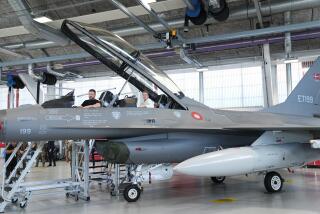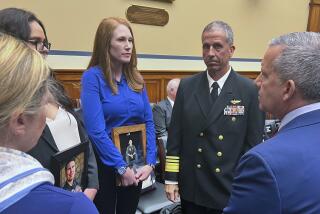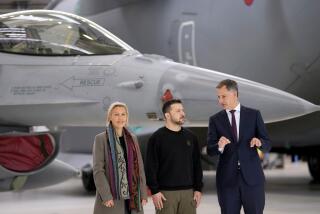Air Force may shrink its F-15 fleet
WASHINGTON — The Air Force will probably order dozens of its F-15 fighter jets permanently grounded because of crucial structural flaws, significantly reducing the number of planes available to protect the United States, officials said Tuesday.
After one of the jets broke apart during a simulated dogfight in November, Air Force officials grounded the entire F-15 fleet, nearly 700 planes in all, fearing such a defect. The newest versions of the fighter jets were allowed to resume flying shortly afterward, but 440 of the older model F-15s have remained out of service.
The Air Force plans to allow about 260 of the remaining grounded planes to return to duty today. But about 180 more will remain idle because of suspected structural flaws.
“Many of them may never fly again,” a senior Air Force officer said. The officer, like others interviewed for this article, spoke on condition of anonymity because results of the investigation are not due to be made public until today.
Long the nation’s most sophisticated front-line fighters, the F-15 are gradually being replaced; many are up to 30 years old. The Air Force still relies on F-15s to protect the continental U.S. and to fly combat missions abroad. Newer model F-15Es are used in combat in Iraq and Afghanistan and were the first of the grounded planes to resume flying after the mishap in November.
The problems with the F-15, Air Force officials argue, have increased the need to purchase more F-22s, swift and stealthy but expensive new fighter planes. Air Force officials characterized the grounding of the F-15s as even more serious than if the Army had to take a large portion of its battle tanks out of service in Iraq.
“This is grave; we’ve had a heart attack,” said a senior Air Force official. “Two hundred of our air superiority aircraft are on the ground, and we are acting like it is business as usual.”
An investigation of the Nov. 2 crash shows the F-15 that broke apart over eastern Missouri had a fault in a crucial support component called a longeron, a structural beam that serves as part of the spine of the aircraft. F-15s have four longerons around the cockpit.
Air Force officials have not yet learned how a defective beam came to be installed in the plane, which was manufactured in 1980. But Air Force officials emphasized that the age of the airframe, combined with the faulty part, puts the older F-15s at risk.
“This airplane broke in half because of a fatigue crack,” the officer said.
The Air Force has found cracks in nine of about 180 planes that remain grounded, but it thinks more have faulty structural beams.
The newer F-15Es are used in Iraq and Afghanistan, and the 440 older fighters -- models F-15A through F-15D -- are used for domestic patrols.
Since the fleet was grounded, the Air Force has used F-16s for patrols. Starting today, the Air Force will use a combination of F-16s and F-15s.
On average, the F-15s are 25 years old and have encountered other structural problems that have forced redesign programs.
Another senior Air Force official said the problems with the F-15 showed an “enhanced imperative” to purchase additional F-22 aircraft. The Air Force has said it needs 381 F-22s, although the Pentagon has approved the acquisition of only 183.
“We have to examine not only if we need the full 381 aircraft, but do we need them faster?” the Air Force official said.
The F-22 has cost billions to develop since it was conceived in the 1980s and remains a controversial plane. Critics have long charged that it is overpriced and was designed for a Cold War threat that no longer exists.
But Air Force officials say the plane is required to retain control of the air and protect American ground forces.
Skeptics of military spending have accused the Air Force of using the F-15’s problems as a justification for purchasing more F-22s. The Air Force, these critics contend, should do more to examine whether the F-15s can be effectively repaired.
But in an interview, Defense Secretary Robert M. Gates said he thought the Air Force faced genuine issues because of its aging fleet. Gates said that replacing the fleet of in-air refueling tankers should be addressed first but that new fighters are a legitimate need.
“The Air Force’s top priority has to be the replacement of the tanker fleet, but I think the notion that the Air Force is somehow pumping up the F-15 problem, I just don’t believe that for a second. I think it’s a real concern,” Gates said.
Air Force officials said they thought some of the F-15s that remained grounded might be able to return to duty after repairs. But some senior officials have raised questions about how effective the F-15s will be after they are fixed. Some officials believe that repairs to stiffen the aircraft could reduce its capability as a fighter plane.
“Do you try to patch a 25-year-old airplane that has been patched and patched and patched?” another senior Air Force official asked. “After the repairs, it will not be the same aircraft it was before.”
Times staff writer Peter Spiegel at Nellis Air Force Base, Nev., contributed to this report.
More to Read
Sign up for Essential California
The most important California stories and recommendations in your inbox every morning.
You may occasionally receive promotional content from the Los Angeles Times.










